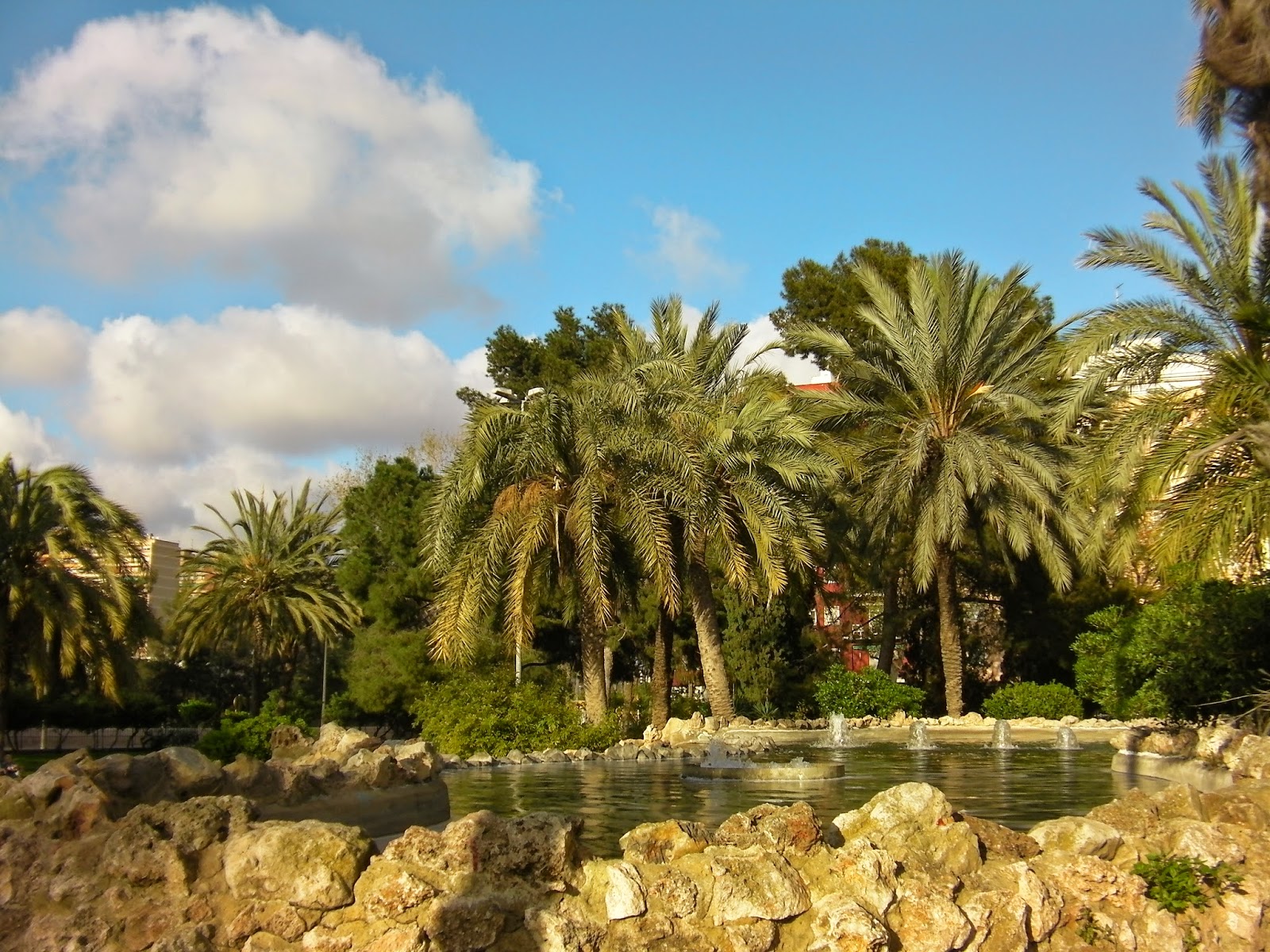Visiting the city of Valencia in Spain for the first time,
we were pleasantly greeted by the subtle aroma of orange blossoms in the air and
the sight of beautiful oranges dangling from the orange trees that line the street
pavements. Whilst many parts of the city are bordered with trees,
there are also other green spaces,
such as beautiful small parks (like the one in the picture shown below),
complete with Mediterranean flora such as palms, ficus, cycas, and orange trees.
The most impressive green space is perhaps the 9 km green belt that runs through the city- the Jardi delTuria (Garden of the Turia), which is a credit to the city. The Turia is a Spanish river that
empties into the Mediterranean near the city of Valencia. In 1957, it flooded and devastated Valencia. Consequently, the course of the river was artifically changed- now running
along
the city edge before meeting the Mediterranean. The original course of
the river continues has been
converted into an enormous green space resplendent with beautiful trees with
pedestrian paths, cycle paths, and occasionally dotted with football grounds, cafes,
athletics tracks, and gardens within the garden. Here city dwellers relax, play, or just get about their business, avoiding the traffic that plies overhead on the
many bridges that cross the river bed. Buildings
tower over either side of the Turia garden, comprising largely of apartment
blocks and businesses. Our walk along the Turia garden in sweltering sunny
April was very pleasant which made me realize the importance of green spaces in
cities.
Urban heat islands and
global warming
Cities have their own micro-climates. Human activities-
buildings made of concrete, asphalt roads , vehicular emissions, heat generated by
people, and heat arising from equipment use, all contribute to temperature
increases in the urban areas to levels that
are significantly higher from the
adjoining rural areas where temperatures remains close to air temperatures. Such
urban areas are called ‘Urban heat islands’, a concept described over 200 years
ago by Luke Howard, the father of meteorology. The term has been coined as the
warmer urban air lies in a ‘sea’ of cooler rural air. According to
the EPA, the annual mean air temperature of a city with 1 million
people or more can be 1.8–5.4°F (1–3°C) warmer than its surroundings, going up
to temperature difference as much as 22°F (12°C) on a clear, calm night.
Heat islands could not only affect the health of the urban
inhabitants by causing heat -related illnesses (a topic discussed in the
earlier post), but also contribute to
global warming in general, and must not be ignored particularly as
predictions indicate that by 2050 about
64% of the developing world and 86% of the developed world will be urbanised
- leading to amplification of the issue. Whilst
urbanisation cannot be halted, it must be made sustainable.
Mitigation strategies
for urban heat island effects
Among the four major strategies United States EnvironmentalProtection Agency (EPA) has suggested for mitigating the effects of urban heat
islands, the first one is increasing tree and vegetation cover. The others are the installation of green
roofs (roofs with plants grown over a waterproof membrane), installation of
cool and reflective roofs (built from materials with high solar reflectance and
high heat emittance), and building cool pavements (made of material with high
solar reflectivity and good water permeability).
In this post, we will look at the EPA’s primary recommendation.
This, in my opinion, is the one with the
maximum impact and the least costliest. The major benefits of increasing trees
and vegetation covers are the following:
They reduce surface and air temperatures by providing shade and
by the process of evapotranspiration. Estimates indicate that evapotranspiration, alone or in combination with shading, can help
reduce peak summer temperatures by 2–9°F (1–5°C). By providing shade to buildings, trees
decrease the demand for air conditioning and indirectly decrease the need for
energy use which, in turn, lowers greenhouse gas emissions and provides better air
quality. Trees also function as ‘sinks’ for air pollutants and carbon dioxide.
Trees improve the quality of life of city dwellers by enhancing the aesthetic value
of their surroundings and promote biodiversity by providing habitats for diverse
species.
Interestingly, it also appears that for some trees living in an urban environment
might not be bad after all. In a study in 2012, seedlings of oak were grown for
one season at four sites along an urban–rural transect from Central Park in New
York City to the Catskill Mountains in upstate New York with a difference in average maximum
temperatures of 2.4 °C and difference in
minimum temperatures of 4.6 °C.
Additionally, seedlings were cultured in growth cabinets
simulating the seasonal differential between
the city and rural sites. The
researchers found that warmer temperatures associated with the urban
environment, especially high night-time temperatures, lead to enhanced growth in
these seedlings.
The necessity for a Green
Channel Programme for our cities
Coming back to our example - Valencia- it appears that the
city is going in the right direction with its tree and vegetation cover
initiatives. The green spaces and the green belts are not only aesthetically
pleasing, but also reduce the heat (personal experience). Increasing the vegetation cover in
cities is something where more is less. Thus, Valencia and other cities who have such initiatives cannot rest on their laurels. We really need to have green channels
through our cities to cool the urban heat islands.
References
http://www.valenciavalencia.com/sights-guide/turia.htm
http://www.epa.gov/heatisland/about/index.htm
Searle, S., Turnbull, M., Boelman, N., Schuster, W., Yakir, D., & Griffin, K. (2012). Urban environment of New York City promotes growth in northern red oak seedlings Tree Physiology, 32 (4), 389-400 DOI: 10.1093/treephys/tps027http://dx.doi.org/10.1093/treephys/tps027">10.1093/treephys/tps027
>Searle, S., Turnbull, M., Boelman, N., Schuster, W., Yakir, D., & Griffin, K. (2012). Urban environment of New York City promotes growth in northern red oak seedlings Tree Physiology, 32 (4), 389-400 DOI: 10.1093/treephys/tps027http://dx.doi.org/10.1093/treephys/tps027">10.1093/treephys/tps027




